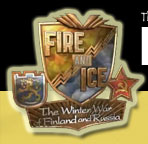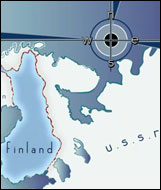

1944 - Finland Fights To Survive
By January 14, the Soviet Union had lifted the siege on Leningrad which opened the possibility for the Red Army to conduct operations against the Finnish lines. In February, Soviet bombings took place in Helsinki, and Mannerheim sees the renewed Red Army as a growing threat to attack the Isthmus or in Eastern Karelia. Mannerheim urged Finnish President Ryti that peace needed to be made quickly. He felt the Finnish Army would not be able to hold off a massive Soviet push. The Finns had meetings with the Soviets in Sweden in February, but the sides were still far apart on the terms of ending the war. In April, the Finns received their first supply of Panzerschrecks and Panzerfausts from the Germans. The Germans hoped these new weapons would improve the Finnish attitude towards the war, but the Finns were still looking for a way to end the war with the Soviets. Hitler became more and more concerned about Finland and its goal to make a separate peace with the USSR. Seven days after the Finns receive these new weapons, Hitler suspended further arms deals to Finland. Hitler hoped this added pressure would force the Finns to stay the course. What neither Hitler nor the Finns knew was that late in April Stalin signed an order to begin the planning of a massive assault against the Finnish forces. The attack was to take place in June, with the attack led from the Karelian Isthmus by a strong Soviet force.
In May the Finns began to notice increased Soviet activity near the Finnish lines on the Karelian Isthmus, but they are unsure if these were preparations for a Soviet attack or a feint to hide the real intentions of the Red Army. Mannerheim became more concerned when he learned the Soviet troops in the area were adhering to strict radio silence. He viewed this as a sure sign of an impending attack. He plead that the work on the various defensive lines be completed, or at least the work be finished in what he deems key areas. Finnish intelligence officer Maj. P. Ketonen passed along his feeling that the Soviets would attack on the Finnish front in June. The Finns tried to step up the progress of the works on the VT (Vammelsuu-Taipale) Line on the Isthmus. The Swedish Army intelligence office secretly passed information to Finnish officers that the Soviet forces were indeed building up for a possible attack with strength on the Isthmus. In mid to late May Mannerheim sent a letter to Hitler asking that Germany reinstate the weapons program to the Finns, and he assures Hitler that the German weapons will not fall into Soviet hands. Hitler did not yield to Mannerheim’s request which leads to Finnish concerns of their stockpile of heavy arms and anti-tank weapons. Even with all the warning signs not all Finns were convinced that a Soviet attack was being planed. In fact, the 4th Army Group HQ issued a statement to Mannerheim stating they felt an attack was not a strong likelihood; however, Mannerheim wisely began to move more forces to the Isthmus to strengthen the Finnish lines in the area.
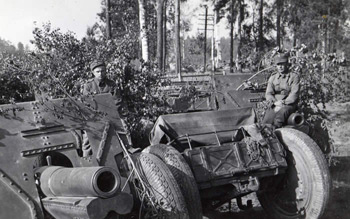
Finnish
howitzers during the Continuation War.
Marshall
Kregel
The Finnish plans for defense in the area were much along the same as the Winter War, which was the dependence on various fortified defensive lines. The main line on the Karelian Isthmus was the VT Line which ran some 80-90 kilometers from Vammelsuu to Taipale. The line did not run straight, but made use of natural terrain and defenses when presented. The line was started in 1941, but by June 1944 there were still sections that were incomplete. Many sections of the VT Line were only a defensive network on the planning room table. Still the line was large and well defended with lines of entrenchments with concrete infantry shelters for 15-20 men, concrete command and observation points, and concrete machine gun positions. There were also larger machine gun and artillery pillboxes grouped on the important heights and roads. VT line had more than 900 installations of various types, vast minefields, armored small-arms positions in the trenches, and there was railway along sections of the line for quick reinforcements and supply. With over 400,000 cubic meters of concrete used, the VT Line was more formidable than the Mannerheim Line of the Winter War.
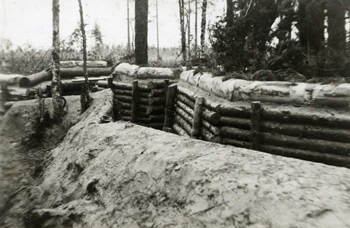
An
example of Finnish defensive trenches.
Marshall Kregel
The Soviet attacks that began in June 1944 were on a massive scale. It was on such a scale that entire world was taken by surprise as most felt the Soviet attacks would focus towards the German forces in or near Poland or a Soviet push into the Baltic States. Instead of this the Soviets decided to launch an attack toward Finland, which it was hoped, would force Finland out of the war. While the Finns were aware the Soviets seemed to be massing their troops, they simply had no idea of the large amount of Soviet troops, artillery, tanks and planes that were to be sent on the Finnish front. The main goals of the Soviet attack were to destroy the Finnish Army on the Isthmus and take back Viipuri (Vyborg). After the first attacks met with success, the general plan was to advance as far Helsinki. There would also be attacks made in Eastern Karelia with the main forces wishing to advance to the area of Ilomantsi. It was hoped these attacks would draw the Germans to the south to assist in defense which would allow another Soviet attack in the northern area of Finland. The overall scale of this attack was stunning and its goals were grand.
The June Attacks On The VT Line
On June 9, massive
Soviet artillery attacks begin on the Karelian Isthmus followed by
a full scale assault
launched by the Red 21st
and 23rd Armies. These armies totaled over 260,000 soldiers, 1,000
aircraft, 7,500+ mortar and artillery pieces, and over 600 tanks
and assault guns. This artillery attack is one of the heaviest launched
in all of World War II. The scale of these attacks is stunning and
the Finns are forced to move backward. The Red Army the Finns were
now facing was a much greater foe than had been faced in the Winter
War. The Red Army had become a well trained killing machine in
the years fighting the Germans. The Finns were seeing the alteration
first hand. When the U.S. ambassador to the USSR heard of the scale
of this attack he contacted Stalin, as the U.S. was still hoping
Finland would take a separate peace. But, Stalin informed him that
the Finns
are stubborn and slow witted, so common sense must be hammered into
dull witted Finnish heads. The Finns had stationed on the Isthmus
two Army Corps, the 3rd and the 4th, which totaled 90,000 total men – so
the Finns were outnumbered over 2 to 1. This ratio was much greater
in regards to planes, artillery, heavy mortars and other heavy equipment.
Over the next three days Mannerheim is forced to shuffle his defensives
as he sends the 3rd Brigade, the 4th Division and the Armored Division
to positions on the Isthmus. This is quickly followed by the moving
of the 20th Brigade and 17th Division to help check this Soviet
advance. By June 14-15 the Soviets broke the VT Line at
Sahakylä and
Kuuterselkä, and the entire front was in peril of being broken.
In the time frame of this battle the Finns once again appealed to
Hitler to supply more arms – mainly AT arms. Hitler decided
that as long as the Finns are fighting he would give (sell) them
arms, but
if he saw the Finns begin to talk of leaving the war
he will not be there to assist Finland again. After heavy fighting
and Finnish counter attacks the VT Line is breeched, forcing the
Finns to retreat. They were able to retreat
intact
and fought delaying actions against the advancing Red Army. As a
result of the breech of the VT Line and the continued Soviet advance,
the city of Viipuri (Vyborg) is lost to the Soviets on June 20.
While the Soviet attacks were impressive and led to a victory, it should be noted that the main goal of destroying the Finnish Army was not achieved. The Finns were forced to concede land and lost a great many men, but the Finnish Army was able to leave the field in order. One key reason for the survival was the smaller groups of Finnish soldiers who covered the rear of the retreat, delaying the Soviet advance and keeping the main Soviet forces from overtaking the Finnish Army. The Finns also put to good use the AT weapons the Germans had supplied. If not for the inspired actions of the Finnish soldiers in this battle the Finnish Army as a whole might have been swallowed by the Soviets.
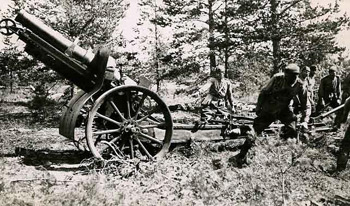
Finnish
artillery in action June 1944.
Brent Snodgrass
Further June Soviet Attacks
On June 21, the Soviets began their attack on the region of the Svir River and on the Masel’ga Isthmus, further north. The Soviet troops on the Svir River were under the command of Soviet Gen. Krutikov whose eight divisions included 340 tanks, 2,500 artillery pieces and mortars, over 700 planes and like armaments. As Mannerheim was forced to move Finnish troops from this region to assist on the Isthmus, the Finnish forces in the area were approximately 50,000. The main defense line the Finns had in the area ran 150 kilometers of the 180 kilometer front and was known as the PSS Line. The PSS Line was strong in its western areas but sections of the line were unfinished and would be open to attack. Mannerheim ordered the Finnish troops to move to the U Position which was a smaller defensive line located to the north. The U Position was only 50 kilometer long, but Mannerheim knew the key battles would be fought in the land surrounding this smaller line. The Finns moved to the rear in a controlled retreat engaging the Soviets in delaying tactics. The Finnish commanders were under orders not to become involved in a large-scale battle with the advancing Soviet forces. The main goal of the Soviets was to engulf the Finnish forces and move into Finland so they could attack the Finnish Isthmus defenders from the rear.
On June 22, Von Ribbentrop unexpectedly arrives in Helsinki. He demands that Finland put in writing that they will not pursue a separate peace with Moscow or else German assistance will be halted. The German Army’s 303rd assault gun brigade arrives in Finland the same day. Unbeknownst to the Germans, the Finns had approached the Soviets earlier in the day about terms for ending the war. On June 24, the Soviets demand that Finland accept an unconditional surrender and Finnish troops in the Eastern Karelia region be moved to the so called PSS defense line. As the 122nd German regiment arrives in Finland the Finns inform the Germans they will stay the course.
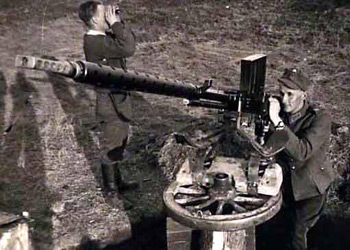
Finnish soldier armed with a L39 altered for
use as an anti-aircraft gun.
Tero-Tuononen-collection
Battle of Tali-Ihantala
The Finns were faced with
the possibility that the Soviets could invade the interior sections
of Finland, which would mean the
death of the Finnish nation. Marshall Mannerheim, his commanders,
the common foot soldiers, and all Finns know that what was to take
place in the coming days would either save or lose the sovereignty
of their country. The Soviets had made attempts to move west after
the earlier battles but they could not press the attack, as such
the Red Army decided to concentrate northeast of Viipuri. The small
village of Tali became the key area for the Soviets as the region
was suited for tanks and there were railroads in the area.
Forces breakdown - Battle of Tali-Ihantala
Finnish Forces
The Finnish Army on the
Isthmus was under the command of Lt. Gen.
Karl Oesch who had three army corps under his control:
Army Corp V of Maj. Gen. Antero Svensson
Army Corp IV of Lt. Gen. Taavetti Laatikainen
Army Corp III of Lt. Gen. Hjalmar Siilasvuo
Finnish Brigades and Divisions
Col. Lauri Haanterä's 3rd Brigade which was under the control of the 18th Division
18th Division Maj. Gen.
Paavo Paalu
3rd Division Maj. Gen. Aaro Pajari
4th Division Maj. Gen. Aleksanteri Autti
6th Division Maj. Gen. Einar Wihma
11th Division Gen. Kaarlo Heiskanen
Maj. Gen. Ruben Lagus's Armored Division as well as the German Sturmgeschütz-Brigade 303.
The Soviet Forces
Marshal Govorov was the overall commander as he was the head of
the military district. Under his control were three armies.
The Soviet 59th Army Lt. Gen. Ivan Korovnikov
The
Soviet 23rd Army Lt. Gen. Alexander Cherepanov
The main Soviet force was the 21st Soviet Army commanded by Col. Gen. Dmitrii Gusev. This army had 14 rifle divisions, tank brigades, heavy artillery, and other heavy support weapons so were quite a strong force.
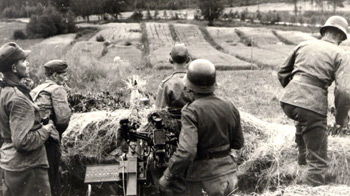
Finnish
anti-tank position
Marshall Kregel
This was the largest battle ever fought in the Nordic region of the world and was the key moment of the war for Finland. The battle began on June 25, with the Soviet forces attacking the Finnish 3rd Brigade stationed between Suomenvedenpohja and Lake Kärstilänjärvi. The losses on both sides of this opening stage of the battle were horrific and were to set the tone for the entire battle. The fighting in the Tali-Ihantala region was as fierce as that seen on any front in World War II. The battle was regulated to an area that was only 10 square kilometers, but this area was filled with troops, tanks, artillery, and the sky above had hundreds of planes engaged in the fighting. From June 25 until July 9 the Finnish and Soviet forces battled for the key positions, with both Armies doing their best to break the backs of their opponents. This battle showed the major improvements to the Finnish artillery that had taken place since the Winter War. Mannerheim had ordered a full one half of all Finnish artillery to take part in this battle and in many cases the Finnish artillery saved the Finnish Army from being overrun. Finnish artillery during the Continuation War was one of the better forces at laying down fast and accurate fire and the results of their ability were thousands of dead Red Army soldiers. By July 9 the Soviet advance had been stopped and was unable to regroup and advance further.
Some of the keys to the Finnish victory:
Soviet supply lines were stretched quite a bit. Re-supply became nearly impossible and as the battle worn on this became a major issue for the Red Army.
Finnish artillery was outstanding in this battle. Their skill in placing accurate fire down quickly saved the Finnish Army time and time again in the back and forth battles that were taking place. The largest portion of the Soviet losses came not from small arm fire but from Finnish artillery fire.
While the more elite Finnish Jaegers and armored units fought well in the battle, all of the Finnish soldiers in their various units performed above and beyond the call of duty. The Finns knew that if they lost the battle their country would be lost as well, so their motivation for performing well was high.
The Soviets also suffered from poor planning. They had felt the battle would be ended quickly and when this did not happen some of the later attacks were rushed or poorly planned. The Soviets at times resorting to nothing more than massive frontal infantry assaults which the Finnish artillery could easily break up.
The Finnish efforts earlier in June had worn down
the Red Army. While the VT Line had been breeched in a short period
of time
the advancing
Soviet troops had to deal with Finnish delaying tactics on an almost
daily bases.
This constant
flow of battle began to show on the Soviet troops.
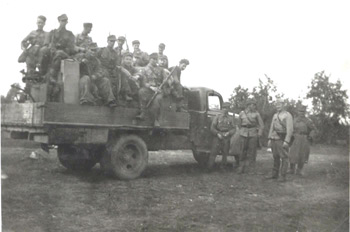
Finnish
troops rushed into battle.
Marshall Kregel

Finnish
armor on the move.
Marshall Kregel
The Aftermath
This was the most important battle
of the war for Finland. Had the Soviets broken the Finnish lines,
it is most likely that Finland
would have lost the war. The Soviets had planned to advance to Helsinki
after this battle, but that was not to be the case. Losses on all
sides were terrible. The Soviets lost over 500 tanks in this battle
and over 22,000 soldiers were killed or wounded. The Finns lost 8,561
in killed or wounded. In the heaviest fighting of July 1-2
the Finns lost almost 800 soldiers a day The Soviets also lost over
250
planes in the fighting. These losses were so great that Stalin began
to rethink the attacks on Finland. Due to this battle the Finns were
able to make a separate peace with Stalin, as he knew that any further
actions against the Finns would be just as difficult. The Soviets
did not need to suffer these large losses so Stalin decided it would
be easier to just let the Finns leave the war on their own. While
there were other battles that would take place after Tali-Ihantala,
this was the last major Soviet push to occupy Finland.

